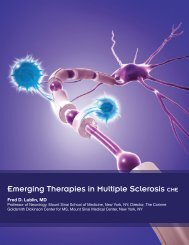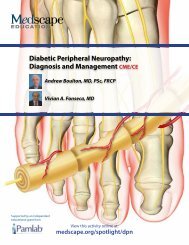Mineral Homeostasis in CKD - Mineral and Bone Disorder - Medscape
Mineral Homeostasis in CKD - Mineral and Bone Disorder - Medscape
Mineral Homeostasis in CKD - Mineral and Bone Disorder - Medscape
Create successful ePaper yourself
Turn your PDF publications into a flip-book with our unique Google optimized e-Paper software.
<strong>M<strong>in</strong>eral</strong> <strong>Homeostasis</strong> <strong>in</strong> <strong>CKD</strong> - <strong>M<strong>in</strong>eral</strong> <strong>and</strong> <strong>Bone</strong><strong>Disorder</strong>: Evolv<strong>in</strong>g Concepts <strong>in</strong> Prevention <strong>and</strong>Treatment CME/CEGeoffrey A. Block, MDDavid M. Spiegel, MDMunro Peacock, DSC, FRCPKathleen M. Hill, PhD, RDSupported by an <strong>in</strong>dependent educational grant fromView this activity onl<strong>in</strong>e at:medscape.org/roundtable/ckdmbd
medscape.org/roundtable/ckdmbdFor Nurses<strong>Medscape</strong>, LLC is accredited as a provider of cont<strong>in</strong>u<strong>in</strong>g nurs<strong>in</strong>g education by the American NursesCredential<strong>in</strong>g Center’s Commission on Accreditation.Awarded 0.50 contact hour(s) of cont<strong>in</strong>u<strong>in</strong>g nurs<strong>in</strong>g education for RNs <strong>and</strong> APNs; 0.50 contact hours are <strong>in</strong> the area ofpharmacology.Accreditation of this program does not imply endorsement by either <strong>Medscape</strong>, LLC or ANCC.Contact this Provider: CME@medscape.netFor questions regard<strong>in</strong>g the content of this activity, contact the accredited provider for this CME/CE activity noted above.For technical assistance, contact CME@medscape.netInstructions for Participation <strong>and</strong> CreditThere are no fees for participat<strong>in</strong>g <strong>in</strong> or receiv<strong>in</strong>g credit for this onl<strong>in</strong>e educational activity. For <strong>in</strong>formation on applicability <strong>and</strong>acceptance of cont<strong>in</strong>u<strong>in</strong>g education credit for this activity, please consult your professional licens<strong>in</strong>g board.This activity is designed to be completed with<strong>in</strong> the time designated on the title page; physicians should claim only those creditsthat reflect the time actually spent <strong>in</strong> the activity. To successfully earn credit, participants must complete the activity onl<strong>in</strong>e dur<strong>in</strong>gthe valid credit period that is noted on the title page. To receive AMA PRA Category 1 Credit, you must receive a m<strong>in</strong>imum score of70% on the post-test.Follow these steps to earn CME/CE credit*:1. Read the target audience, learn<strong>in</strong>g objectives, <strong>and</strong> author disclosures.2. Study the educational content onl<strong>in</strong>e or pr<strong>in</strong>ted out.3. Onl<strong>in</strong>e, choose the best answer to each test question. To receive a certificate, you must receive a pass<strong>in</strong>g score as designatedat the top of the test. <strong>Medscape</strong> Education encourages you to complete the Activity Evaluation to provide feedback forfuture programm<strong>in</strong>g.You may now view or pr<strong>in</strong>t the certificate from your CME/CE Tracker. You may pr<strong>in</strong>t the certificate but you cannot alter it. Creditswill be tallied <strong>in</strong> your CME/CE Tracker <strong>and</strong> archived for 6 years; at any po<strong>in</strong>t with<strong>in</strong> this time period you can pr<strong>in</strong>t out the tally aswell as the certificates by access<strong>in</strong>g “Edit Your Profile” at the top of your <strong>Medscape</strong> homepage.*The credit that you receive is based on your user profile.Hardware/Software RequirementsTo access <strong>Medscape</strong> Education users will need• A computer with an Internet connection.• Internet Explorer 6.x or higher, Firefox 2.x or higher, Safari 2.x or higher, or any other W3C st<strong>and</strong>ards compliant browser.• Adobe Flash Player <strong>and</strong>/or an HTML5 capable browser may be required for video or audio playback.• Occasionally other additional software may required such as PowerPo<strong>in</strong>t or Adobe Acrobat Reader.Authors <strong>and</strong> DisclosuresAs an organization accredited by the ACCME, <strong>Medscape</strong>, LLC, requires everyone who is <strong>in</strong> a position to control the content of aneducation activity to disclose all relevant f<strong>in</strong>ancial relationships with any commercial <strong>in</strong>terest. The ACCME def<strong>in</strong>es “relevantPg.3
medscape.org/roundtable/ckdmbdDr. Hill does not <strong>in</strong>tend to discuss <strong>in</strong>vestigational drugs, mechanical devices, biologics, or diagnostics not approved by the FDA foruse <strong>in</strong> the United States.EditorAnne G. Le, PharmD, RPhScientific Director, <strong>Medscape</strong>, LLCDisclosure: Anne G. Le, PharmD, RPh, has disclosed no relevant f<strong>in</strong>ancial relationships.CME ReviewerNafeez Zawahir, MDCME Cl<strong>in</strong>ical Director, <strong>Medscape</strong>, LLCDisclosure: Nafeez Zawahir, MD, has disclosed no relevant f<strong>in</strong>ancial relationships.Nurse PlannerLaurie Scudder, DNP, NPNurse Planner, <strong>Medscape</strong>, LLCDisclosure: Laurie Scudder, DNP, NP, has disclosed no relevant f<strong>in</strong>ancial relationships.Pg.5
medscape.org/roundtable/ckdmbdDr. Block: We are here <strong>in</strong> Philadelphia, Pennsylvania, at the 2011 American Society of Nephrology Kidney Week. Our goal is todiscuss the cl<strong>in</strong>ical significance of new research data presented here at the meet<strong>in</strong>g on calcium balance <strong>in</strong> chronic kidney diseasem<strong>in</strong>eral<strong>and</strong> bone disorder (<strong>CKD</strong>-MBD). Of course, data discussed here that have been presented as an abstract at a cl<strong>in</strong>ical meet<strong>in</strong>gshould be considered prelim<strong>in</strong>ary until published <strong>in</strong> a peer-reviewed journal. I would also like to note that throughout thisactivity, I will ask <strong>in</strong>teractive questions to gauge your knowledge of this area. When you click on your answer, you will be able tosee how your peers have answered.Dr. Block: How you would answer this question?What percentage of patients with <strong>CKD</strong> have m<strong>in</strong>eral <strong>and</strong> bone disorders?l < 25%l 25%-50%l 50%-75%l > 75%Pg.7
<strong>M<strong>in</strong>eral</strong> <strong>Homeostasis</strong> <strong>in</strong> <strong>CKD</strong> - <strong>M<strong>in</strong>eral</strong> <strong>and</strong> <strong>Bone</strong> <strong>Disorder</strong>: Evolv<strong>in</strong>g Concepts <strong>in</strong> Prevention <strong>and</strong> Treatment CME/CEDr. Block: David, to start us off, perhaps you could guide us. How you would beg<strong>in</strong> to answer this question?Dr. Speigel: It is a tough question to answer. First of all, <strong>CKD</strong> is a grow<strong>in</strong>g epidemic <strong>in</strong> this country, driven by obesity, hypertension,smok<strong>in</strong>g, <strong>and</strong> lipid disorders. Determ<strong>in</strong><strong>in</strong>g what percentage of patients have the bone <strong>and</strong> m<strong>in</strong>eral disorder of <strong>CKD</strong> dependsa little bit on how you def<strong>in</strong>e the condition. Kidney Disease: Improv<strong>in</strong>g Global Outcomes (KDIGO) has def<strong>in</strong>ed <strong>CKD</strong>-MBD as acomplex <strong>in</strong>teraction of both laboratory abnormalities, bone disease, <strong>and</strong> vascular disease. [1]We know now that, early on, there are hormonal changes that occur long before we see m<strong>in</strong>eral changes <strong>in</strong> patients with <strong>CKD</strong>.Very early on, we have parathyroid hormone (PTH) elevations <strong>in</strong> <strong>CKD</strong>, <strong>and</strong> now there are also data that FGF-23 [fibroblast growthfactor-23] levels rise early <strong>in</strong> <strong>CKD</strong>. We know that 1,25-dihydroxyvitam<strong>in</strong> D levels also fall early <strong>in</strong> <strong>CKD</strong>. Those th<strong>in</strong>gs happen beforewe see changes <strong>in</strong> calcium <strong>and</strong> phosphorus, so the answer to the question of what percent of patients have bone <strong>and</strong> m<strong>in</strong>eraldisorders depends on how you def<strong>in</strong>e MBD. Certa<strong>in</strong>ly, if you def<strong>in</strong>e it as an elevated phosphorus [level], then that occurs late <strong>in</strong><strong>CKD</strong>, <strong>and</strong> only about 20% of patients will have elevated phosphorus levels, even as late as stage 4. If you def<strong>in</strong>e it as elevated PTHlevels, then that percentage is higher because it occurs very early.<strong>CKD</strong>-MBD also <strong>in</strong>volves abnormalities of bone, which probably also occur very early <strong>in</strong> <strong>CKD</strong>. KDIGO has given us parameters forevaluat<strong>in</strong>g bone disease <strong>in</strong> terms of turnover, m<strong>in</strong>eralization, volume, <strong>and</strong> -- <strong>in</strong> children at least -- l<strong>in</strong>ear growth of bone. We knowthat <strong>CKD</strong> is accompanied by decreased bone strength, which is the hardest parameter to measure, but the end result is we knowthat our patients have fracture at a very high rate. Vascular calcification is also a common phenomenon <strong>in</strong> patients with <strong>CKD</strong>. Itprobably progresses as patients progress through stages of kidney disease, <strong>and</strong> by the time people are on dialysis, it is verycommon to f<strong>in</strong>d both <strong>in</strong>timal <strong>and</strong> medial vascular calcification.Pg.8
medscape.org/roundtable/ckdmbdDr. Block: Now I would like to ask the second poll<strong>in</strong>g question.In <strong>CKD</strong>, at what stage of kidney function do abnormalities <strong>in</strong> m<strong>in</strong>eral <strong>and</strong> bone first appear?l Stage 2l Stage 3l Stage 4l Stage 5Dr. Speigel: As soon as you can document that there is a decrease <strong>in</strong> glomerular filtration rate (GFR), I th<strong>in</strong>k you can showhormonal changes <strong>in</strong> a large percentage of patients, especially if you look carefully at FGF-23.Pg.9
<strong>M<strong>in</strong>eral</strong> <strong>Homeostasis</strong> <strong>in</strong> <strong>CKD</strong> - <strong>M<strong>in</strong>eral</strong> <strong>and</strong> <strong>Bone</strong> <strong>Disorder</strong>: Evolv<strong>in</strong>g Concepts <strong>in</strong> Prevention <strong>and</strong> Treatment CME/CEIn terms of the process of what happens <strong>in</strong> patients with <strong>CKD</strong>, we know that hormonal abnormalities occur early on, <strong>and</strong> we canpredict what will happen to these patients once they have a diagnosis of <strong>CKD</strong>. The disease is associated with very high mortality,<strong>and</strong> that mortality risk <strong>in</strong>creases as <strong>CKD</strong> progresses. By the time patients are on dialysis, <strong>in</strong> this country at least, the mortality rateis more than 20%. The problem with treatment of patients with <strong>CKD</strong> is that we have a lot of what I will call “observational risk data,”which show that patients with elevated serum phosphorus, elevated calcium, elevated PTH, <strong>and</strong> now elevated FGF-23 [levels] allhave an <strong>in</strong>creased mortality.Then we have another set of data, which I call “observational treatment data,” show<strong>in</strong>g that patients who get placed on phosphateb<strong>in</strong>ders early may have improved survival. Patients who get treated with active vitam<strong>in</strong> D analogues may have improved survival,<strong>and</strong> patients who get treated with calcimimetics may also have an improved survival, but all these data are observational. I th<strong>in</strong>kwe have some very positive <strong>in</strong>formation -- a “bright cloud,” if you will -- that shows we underst<strong>and</strong> more <strong>and</strong> more about thekidney-bone-vascular axis. But we also have a “dark cloud” hang<strong>in</strong>g over our field, <strong>in</strong> that we have not done the large outcomestudies to guide us <strong>in</strong> how to treat these patients at different stages of <strong>CKD</strong>.Dr. Block: It is remarkable that we do not have any outcome studies, whether it be <strong>in</strong> <strong>CKD</strong> stages 2, 3, 4, or 5, regard<strong>in</strong>g thetreatment of MBD to tangibly affect patient outcomes. One of the key th<strong>in</strong>gs that you mentioned with regard to how we view<strong>CKD</strong>-MBD now is the shift <strong>in</strong> focus from composite laboratory bone calcification to the real mean<strong>in</strong>gful th<strong>in</strong>g, which is, “What ishappen<strong>in</strong>g to your patients? Are they hav<strong>in</strong>g fractures? Are they liv<strong>in</strong>g longer? Do they feel better? Are they go<strong>in</strong>g <strong>in</strong> the hospital?”Those are the th<strong>in</strong>gs that we need to be study<strong>in</strong>g that we are just not study<strong>in</strong>g yet.It appears that very early <strong>in</strong> <strong>CKD</strong>, probably long before the patient ever gets referred to a nephrologist, we can beg<strong>in</strong> to see theseabnormalities. As you just po<strong>in</strong>ted out, data are show<strong>in</strong>g that regulatory hormones may be the first <strong>in</strong>dicator of abnormalities <strong>in</strong><strong>CKD</strong>-MBD. You mentioned a few of those regulatory markers like FGF <strong>and</strong> 1,25 vitam<strong>in</strong> D. Dr. Peacock, I would like to hear yourthoughts on how our underst<strong>and</strong><strong>in</strong>g of the early physiology of <strong>CKD</strong> has evolved dramatically over the last few years.Dr. Peacock: The central issue is that the kidney is the ma<strong>in</strong> excretory organ for calcium <strong>and</strong> phosphate, so an adult <strong>in</strong> balance isabsorb<strong>in</strong>g, say, 200 mg of calcium <strong>and</strong> 800 mg of phosphate. Most of that has to come out <strong>in</strong> ur<strong>in</strong>e. As soon as the GFR drops, thebody still has to cont<strong>in</strong>ue to excrete that amount, unless <strong>in</strong>take or absorption decrease, so calcium <strong>and</strong> phosphate <strong>in</strong> the plasma<strong>in</strong>crease. That sets up an alarm <strong>in</strong> the endocr<strong>in</strong>e system, which wants to keep calcium <strong>and</strong> phosphate serum concentrationsnormal because of the very vital actions of calcium <strong>and</strong> phosphate <strong>in</strong> tissues. And so the endocr<strong>in</strong>e system is alerted. We haveknown for many years that when you decrease the GFR below, say, 60 mL/m<strong>in</strong>/1.73 m 2 , then PTH secretion is <strong>in</strong>creased <strong>and</strong> thatleads to hyperparathyroid (HPT) bone disease. We also know that the hormonal form of vitam<strong>in</strong> D, 1,25-dihydroxyvitam<strong>in</strong> D3made <strong>in</strong> the kidney, also decreases, <strong>and</strong> that eventually leads to osteomalacia. The rise <strong>in</strong> serum calcium <strong>and</strong> phosphate thatoccurs later certa<strong>in</strong>ly leads to ectopic calcification <strong>in</strong> soft tissues, particularly <strong>in</strong> blood vessels. So, it is these 3 actions that occur.Pg.10
medscape.org/roundtable/ckdmbdBut if we look at a patient who has early renal failure, that, I th<strong>in</strong>k, is where the action is. In the last decade it has becomeobvious, first of all, that the normal population is mov<strong>in</strong>g <strong>in</strong>to renal failure with ag<strong>in</strong>g <strong>and</strong> with a number of other conditions,such as hypertension <strong>and</strong> diabetes. There are many patients whom we call normal but who are <strong>in</strong> early renal failure. We havecome to realize that plasma phosphate is a marker of morbidity <strong>and</strong> mortality <strong>in</strong> this population <strong>and</strong>, of course, <strong>in</strong> the populationwho has established or well-recognized renal failure.The other th<strong>in</strong>g that has really changed the field is that we have discovered the hormone that regulates phosphate. It wasunknown 10 years ago. Now we know that fibroblast growth factor, FGF-23, acts on the kidney to do 2 th<strong>in</strong>gs. First, it allowsthe kidney to excrete more phosphate <strong>and</strong> br<strong>in</strong>gs the phosphate back down, <strong>and</strong> second -- very important -- it regulates1,25-dihydroxyvitam<strong>in</strong> D3 production, which regulates phosphate absorption. All of this has moved the field <strong>in</strong>to look<strong>in</strong>g at theearliest effects of renal failure. This is of <strong>in</strong>terest not only to nephrologists but also to people <strong>in</strong> medic<strong>in</strong>e <strong>and</strong> the endocr<strong>in</strong>ologists<strong>and</strong> dietitians <strong>and</strong> all the other groups who are <strong>in</strong>terested <strong>in</strong> the healthy population.Dr. Block: And cardiology as well. Before, when we talked about cardiorenal syndromes, we focused ma<strong>in</strong>ly on how cardiac pumpfunction is altered by kidney changes. Now we are learn<strong>in</strong>g that, when the kidney changes early, these hormones affect the heart<strong>and</strong> may play a role <strong>in</strong> why the heart ultimately fails.I am sure all of us have read with great <strong>in</strong>terest the article by Christian Faul <strong>and</strong> colleagues, with Myles Wolf as the senior author,that was just published <strong>in</strong> Journal of Cl<strong>in</strong>ical Investigation. The article is a really solid piece of work that has brought together theconcept of cardiac-renal homeostasis. It centers on phosphorus, which is <strong>in</strong>terest<strong>in</strong>g. Katie, maybe you can help talk about that alittle bit.Pg.11
<strong>M<strong>in</strong>eral</strong> <strong>Homeostasis</strong> <strong>in</strong> <strong>CKD</strong> - <strong>M<strong>in</strong>eral</strong> <strong>and</strong> <strong>Bone</strong> <strong>Disorder</strong>: Evolv<strong>in</strong>g Concepts <strong>in</strong> Prevention <strong>and</strong> Treatment CME/CEDr. Hill: Yes. This study by Faul <strong>and</strong> colleagues showed that, <strong>in</strong> patients with <strong>CKD</strong>, elevated FGF-23 is <strong>in</strong>dependently associatedwith left ventricular hypertrophy (LVH). Through a series of very nice experiments <strong>in</strong> both cell <strong>and</strong> tissue, they showed that FGF-23plays a causal role <strong>in</strong> the pathogenesis of LVH <strong>and</strong> that this role is not dependent on the coreceptor klotho, which is present <strong>and</strong>necessary for FGF-23 action <strong>in</strong> the parathyroid <strong>and</strong> the kidney. This f<strong>in</strong>d<strong>in</strong>g shows that chronically elevated FGF-23 levels <strong>in</strong> thesepatients are important for the high rates of LVH <strong>and</strong> the high rates of mortality that we see <strong>in</strong> <strong>in</strong>dividuals with <strong>CKD</strong>.Dr. Block: David, you mentioned that mortality is 20% per year <strong>in</strong> the end-stage renal disease (ESRD) population, but I f<strong>in</strong>d itamaz<strong>in</strong>g that with GFRs of 45 mL/m<strong>in</strong>/1.73 m2, the cardiovascular hospitalization rate, the cardiovascular event rate, is 5 or 10times higher. We are talk<strong>in</strong>g about people with normal CHEM-7s [blood chemistry values], normal hemoglob<strong>in</strong> values -- what ostensiblylooks like normal biochemistry. But as you po<strong>in</strong>t out, Katie, the FGF article changes everyth<strong>in</strong>g. It puts phosphate homeostasispotentially at the center of these cardiovascular events. Yet, nephrologists <strong>in</strong> general are quite uncerta<strong>in</strong> about how to wemanage phosphorus over the course of evolv<strong>in</strong>g <strong>CKD</strong>. That is the hot topic.Now that we have this wonderful piece of work show<strong>in</strong>g that FGF-23 is related to LV mass <strong>and</strong> is likely to be related to events,how do we lower it? How do we treat people with disorders of phosphorus, <strong>and</strong> what do we have available to us? Right now theonly th<strong>in</strong>g we have available are phosphate b<strong>in</strong>ders. We have <strong>in</strong>terventional trial data on those agents, but they have never beenlooked at <strong>in</strong> terms of hard outcomes. Katie, maybe you can share your thoughts about our choices of phosphate b<strong>in</strong>ders <strong>and</strong> theiradvantages <strong>and</strong> disadvantages.Pg.12
medscape.org/roundtable/ckdmbdDr. Hill: The 2 ma<strong>in</strong> categories of phosphate b<strong>in</strong>ders are calcium-based <strong>and</strong> non-calcium-based. The commonly usedcalcium-based ones are calcium acetate, which is 25% elemental calcium, <strong>and</strong> calcium carbonate, which is 40% elemental calcium.With calcium-based b<strong>in</strong>ders, there is always the possibility of hypercalcemia or perhaps progress<strong>in</strong>g calcium phosphatedeposition if that is present. The non-calcium-based b<strong>in</strong>ders are sevelamer, <strong>in</strong> the forms of sevelamer hydrochloride <strong>and</strong>sevelamer carbonate, <strong>and</strong> lanthanum carbonate. These b<strong>in</strong>d phosphate as anion exchangers <strong>and</strong> do not necessarily have theeffect of hypercalcemia <strong>in</strong> patients.However, there are limited outcome data to suggest use of one phosphate b<strong>in</strong>der over another. Studies compar<strong>in</strong>g calcium-based<strong>and</strong> non-calcium-based b<strong>in</strong>ders have <strong>in</strong>vestigated mortality, vascular calcification, <strong>and</strong> bone outcomes. While some of thesestudies have shown a benefit of us<strong>in</strong>g the non-calcium-based b<strong>in</strong>ders such as sevelamer over calcium carbonate, others haveshown no difference. There is still uncerta<strong>in</strong>ty about what the data are show<strong>in</strong>g us, so we need more studies with hard outcomedata on mortality <strong>and</strong> fractures to be able to determ<strong>in</strong>e which phosphate b<strong>in</strong>ders are best to use.Pg.13
<strong>M<strong>in</strong>eral</strong> <strong>Homeostasis</strong> <strong>in</strong> <strong>CKD</strong> - <strong>M<strong>in</strong>eral</strong> <strong>and</strong> <strong>Bone</strong> <strong>Disorder</strong>: Evolv<strong>in</strong>g Concepts <strong>in</strong> Prevention <strong>and</strong> Treatment CME/CEDr. Block: You br<strong>in</strong>g up a great po<strong>in</strong>t. David <strong>and</strong> I have done some of that work, <strong>and</strong> I agree with you -- some of the researchpo<strong>in</strong>ts <strong>in</strong> one direction <strong>and</strong> some po<strong>in</strong>ts <strong>in</strong> the other direction, <strong>and</strong> so there is uncerta<strong>in</strong>ty. One of the th<strong>in</strong>gs that you brought upwith calcium vs noncalcium agents is whether serum calcium values should be the marker by which we evaluate their safety. Arethese drugs safe because they do, or do not, <strong>in</strong>crease serum calcium? I th<strong>in</strong>k all of you have done some work with regard to howmuch calcium actually gets <strong>in</strong>to us. What is the calcium balance? As you said, Munro, the physiology we try to ma<strong>in</strong>ta<strong>in</strong> is a neutralbalance as you reach a steady state -- the “<strong>in</strong>” equals the “out.” But when we provide this elemental calcium load <strong>in</strong> the form of calciumb<strong>in</strong>ders, we run <strong>in</strong>to some potential problems. One of the excit<strong>in</strong>g th<strong>in</strong>gs at this year’s meet<strong>in</strong>g are the abstracts that both ofyou have submitted with regard to calcium balance. We have had very little calcium balance data or phosphorus balance data <strong>in</strong>the past 20 years. Katie, maybe you can share with us a little bit about your work with Dr. Peacock on this <strong>and</strong> how you approachthis balance issue.Dr. Hill: What I will show you with our data is that you can have very high positive calcium balance but serum calcium rema<strong>in</strong>scompletely normal -- you have not affected it. At the ASN [American Society of Nephrology] meet<strong>in</strong>g this year, we are report<strong>in</strong>gour results from a study <strong>in</strong> patients with stage 3 <strong>and</strong> 4 <strong>CKD</strong>, where we measured calcium balance <strong>and</strong> phosphate balance while thepatients were on a controlled calcium <strong>and</strong> phosphate diet. We previously reported our calcium balance data <strong>in</strong> these patients atthe American Society of <strong>Bone</strong> <strong>and</strong> <strong>M<strong>in</strong>eral</strong> Research <strong>in</strong> September 2011. What we found is that, as expected, when patients aregiven 1500 mg per day of elemental calcium <strong>in</strong> the form of a calcium carbonate phosphate b<strong>in</strong>der, fecal calcium <strong>in</strong>creases from884 mg per day to just over 2000 mg per day. Ur<strong>in</strong>ary calcium, however, is unaffected. Patients are absorb<strong>in</strong>g a lot more netcalcium, but they are not excret<strong>in</strong>g any more <strong>in</strong> their ur<strong>in</strong>e. This is a problem that results <strong>in</strong> a positive calcium balance. We can seethat, on placebo, when the patients were on a basal diet of around 1000 mg of calcium per day, they essentially were <strong>in</strong> neutralcalcium balance, but given the 1500 mg of calcium from the phosphate b<strong>in</strong>der, they went up to around 400 mg positive calciumbalance. This was a significant difference, be<strong>in</strong>g able to produce a pretty substantial positive calcium balance by giv<strong>in</strong>g thisphosphate b<strong>in</strong>der. We did not see any differences <strong>in</strong> serum calcium, so we were not produc<strong>in</strong>g hypercalcemia <strong>in</strong> these patients.Dr. Block: That is fundamentally important for how we treat these patients, particularly if we are go<strong>in</strong>g to start treat<strong>in</strong>g them early.Given the FGF data, the temptation is to start us<strong>in</strong>g phosphate b<strong>in</strong>ders very early <strong>in</strong> the course of <strong>CKD</strong>-MBD. I th<strong>in</strong>k we have toshow a little restra<strong>in</strong>t, because we do not have the cl<strong>in</strong>ical studies to demonstrate whether or not us<strong>in</strong>g cl<strong>in</strong>ical doses of a b<strong>in</strong>derto produce nearly 400 mg per day of positive calcium balance will turn out to be beneficial.Dr. Peacock: This is of concern to the population with osteoporosis <strong>and</strong> the elderly. Many of these patients are <strong>in</strong> early renalfailure, <strong>and</strong> one of the st<strong>and</strong>ard therapies is calcium supplementation. We hope the calcium is go<strong>in</strong>g <strong>in</strong>to the bone, but of coursethere is no way of know<strong>in</strong>g that it is not go<strong>in</strong>g <strong>in</strong>to the soft tissues.Pg.14
medscape.org/roundtable/ckdmbdDr. Block: Some recent meta-analyses suggest that giv<strong>in</strong>g calcium supplementation may not be good for cardiovascular risk <strong>in</strong>that population. In your data, Katie, even with 1000 mg of calcium, your patients were essentially neutral or slightly positive.Your f<strong>in</strong>d<strong>in</strong>g that serum calcium does not change makes the po<strong>in</strong>t that we cannot rely on that. It may also be true that serumphosphorus does not reflect phosphate load or balance quite so well.Dr. Speigel: This is fundamentally important. We th<strong>in</strong>k of this when we th<strong>in</strong>k of potassium balance <strong>and</strong> sodium balance <strong>in</strong> <strong>CKD</strong>.We know patients with <strong>CKD</strong> have a limited ability to h<strong>and</strong>le loads of potassium <strong>and</strong> of sodium, <strong>and</strong> we adjust the dietary <strong>in</strong>taketo meet what the kidney can put out. What we are clearly f<strong>in</strong>d<strong>in</strong>g now is that the same is true with calcium <strong>and</strong> probably withphosphorus. We need to th<strong>in</strong>k more about adjust<strong>in</strong>g <strong>in</strong>take to match what the kidney is able to put out.Dr. Block: That is absolutely true.Dr. Hill: We also have correspond<strong>in</strong>g data for the phosphate balance. This is really <strong>in</strong>terest<strong>in</strong>g too, because you are giv<strong>in</strong>g a levelof calcium that is quite high -- 1500 mg per day -- which, as you mentioned, is what is used cl<strong>in</strong>ically. The effect on phosphatebalance is very m<strong>in</strong>imal, so we also gave a controlled diet of 1500 mg of phosphate, <strong>and</strong> there was no difference between eitherplacebo or calcium. Fecal phosphate was unaffected. Ur<strong>in</strong>e phosphate was decreased with the calcium supplement, which waswhat you would hope to see, but only by about 170 mg per day, which was a pretty modest effect. Phosphate balance was notdifferent. It was essentially neutral <strong>in</strong> both of the conditions of the treatment. So, there was a huge effect on calcium balance but apretty modest effect on phosphate throughput <strong>and</strong> b<strong>in</strong>d<strong>in</strong>g phosphate.Dr. Block: This work makes us question our st<strong>and</strong>ard th<strong>in</strong>k<strong>in</strong>g <strong>and</strong> our st<strong>and</strong>ard approach to what we are do<strong>in</strong>g. People havethe perception that this is a benign event. We have been us<strong>in</strong>g phosphate b<strong>in</strong>ders forever, <strong>and</strong> we will just give our patientsphosphate b<strong>in</strong>ders earlier. But what your data po<strong>in</strong>t out is that there are some concerns that we need to be aware of <strong>in</strong> thatregard.You cannot talk about the issue of calcium balance, <strong>CKD</strong>-MBD, <strong>and</strong> calcium vs noncalcium without gett<strong>in</strong>g to the basic issue ofvitam<strong>in</strong> D <strong>and</strong> PTH <strong>and</strong> the management of hyperparathyroidism. As both of you described earlier, FGF seems to be one of theproximate reasons why 1,25-dihydroxyvitam<strong>in</strong> D3 goes down as you lose kidney function. When you reach ESRD, of course, wetreat hyperparathyroidism with pretty large doses of vitam<strong>in</strong> D <strong>and</strong>/or use of a calcimimetic. Dr. Peacock, you are <strong>in</strong>volved <strong>in</strong> somestudies presented here that are <strong>in</strong>terest<strong>in</strong>g with regard to compar<strong>in</strong>g how those 2 drugs work.Pg.15
<strong>M<strong>in</strong>eral</strong> <strong>Homeostasis</strong> <strong>in</strong> <strong>CKD</strong> - <strong>M<strong>in</strong>eral</strong> <strong>and</strong> <strong>Bone</strong> <strong>Disorder</strong>: Evolv<strong>in</strong>g Concepts <strong>in</strong> Prevention <strong>and</strong> Treatment CME/CEDr. Peacock: In the past, the management has been to do a surgical parathyroidectomy, or to do a partial procedure so that youleave some of the parathyroid tissue <strong>in</strong>, <strong>and</strong> br<strong>in</strong>g down the parathyroid blood level. That is very difficult to do, <strong>and</strong> so we are veryfortunate, I th<strong>in</strong>k, hav<strong>in</strong>g 2 classes of drugs that allow us to attempt, if you will, a medical parathyroidectomy.The first class of drugs is based on 1,25-dihydroxyvitam<strong>in</strong> D. In addition to <strong>in</strong>creas<strong>in</strong>g calcium absorption, these drugs act todecrease the secretion of PTH directly. A number of these analogues have been developed. The goal <strong>in</strong> us<strong>in</strong>g these is to br<strong>in</strong>gdown the serum PTH <strong>and</strong> not to <strong>in</strong>crease calcium absorption from the gut or calcium resorption <strong>and</strong> phosphate resorption frombone. These agents are very effective.The second group are the calcimimetics, <strong>and</strong> they act through a different mechanism. They act on the calcium-sens<strong>in</strong>greceptor, which is present <strong>in</strong> a number of tissues, <strong>in</strong>clud<strong>in</strong>g the parathyroid gl<strong>and</strong>. The allosteric calcimimetics sensitize the gl<strong>and</strong>to the presence of calcium, <strong>and</strong> so they decrease PTH. There are 2 different mechanisms <strong>in</strong>volved. One acts on PTH directly <strong>and</strong>also <strong>in</strong>creases calcium <strong>and</strong> phosphate absorption from gut, whereas the other one decreases PTH but does so <strong>in</strong> a pulsatilefashion. Where there is kidney function present, this has an effect on <strong>in</strong>creas<strong>in</strong>g bone turnover markers. So, they have a slightlydifferent action, as one might th<strong>in</strong>k. Further work is needed develop<strong>in</strong>g these 2 types of drug. Ideally we will have a drug that onlyacts on the parathyroid receptor <strong>in</strong> terms of the vitam<strong>in</strong> D, <strong>and</strong> the same for the calcimimetic.Pg.16
medscape.org/roundtable/ckdmbdDr. Block: A trial presented here this week, the IMPACT-SHPT trial, directly compares the protocols that use vitam<strong>in</strong> D-basedtherapies with c<strong>in</strong>acalcet-based therapies. Much to many people’s surprise, these <strong>in</strong>vestigators found that PTH suppression wasquite good with both therapies <strong>and</strong> was even a little better <strong>in</strong> the paricalcitol treatment arm. The bone markers that youmentioned did not really go <strong>in</strong> the direction that we had expected.Dr. Peacock: If you look at the work <strong>in</strong> primary hyperparathyroidism, giv<strong>in</strong>g the calcimimetic <strong>in</strong>creases bone turnover. Aga<strong>in</strong>,I th<strong>in</strong>k it is the pulsatile effect on PTH, which is anabolic to the skeleton. I do not th<strong>in</strong>k the nephrologists should be so worriedbecause the bone markers go up. That may be a good th<strong>in</strong>g. You actually may be stimulat<strong>in</strong>g new bone formation, so I th<strong>in</strong>kfurther studies are needed along these l<strong>in</strong>es to see exactly what we are do<strong>in</strong>g to the bone.Dr. Block: There is a trial that has been go<strong>in</strong>g on for roughly 3.5 or 4 years to look at hard outcomes related to c<strong>in</strong>acalcet-basedtherapies vs st<strong>and</strong>ard vitam<strong>in</strong> D-based therapies. Hopefully next year, if we have this same conversation, we will have some datato discuss if that trial f<strong>in</strong>ishes <strong>and</strong> we get a chance to look at itPg.17
<strong>M<strong>in</strong>eral</strong> <strong>Homeostasis</strong> <strong>in</strong> <strong>CKD</strong> - <strong>M<strong>in</strong>eral</strong> <strong>and</strong> <strong>Bone</strong> <strong>Disorder</strong>: Evolv<strong>in</strong>g Concepts <strong>in</strong> Prevention <strong>and</strong> Treatment CME/CEDr. Peacock: Studies are needed where we comb<strong>in</strong>e these therapies. Aga<strong>in</strong>, this may be an approach that is very useful.Dr. Block: David, you have done some studies similar to Katie’s look<strong>in</strong>g at calcium balance <strong>and</strong> have participated <strong>in</strong> somer<strong>and</strong>omized trials of phosphate b<strong>in</strong>der use. What is your thought on calcium-based phosphate b<strong>in</strong>ders, <strong>and</strong> the role of calciumbalance <strong>in</strong> manag<strong>in</strong>g early <strong>CKD</strong>-MBD?Dr. Speigel: We had an abstract at last year’s ASN, which yielded data very similar to Katie’s, <strong>in</strong> that patients with <strong>CKD</strong> on 2000 mgof calcium <strong>in</strong>take are <strong>in</strong> marked positive calcium balance. Certa<strong>in</strong>ly, the 2 studies seem to be f<strong>in</strong>d<strong>in</strong>g the same th<strong>in</strong>gs. That paper iscurrently under review.The question is, is there a role for calcium-based phosphate b<strong>in</strong>ders <strong>in</strong> any stage of <strong>CKD</strong>? If patients with <strong>CKD</strong> follow our recommendations<strong>in</strong> terms of diet <strong>and</strong> restrict their milk <strong>and</strong> dairy <strong>in</strong>take, it is possible that their calcium <strong>in</strong>take can drop quite low. It iseven possible, I th<strong>in</strong>k, that some people could be <strong>in</strong> negative calcium balance if they are on a very restricted diet. So, there maybe a little bit of a role <strong>in</strong> those patients for some calcium supplementation or even for some calcium-based b<strong>in</strong>ders, but I th<strong>in</strong>kwe have to be very cautious about that recommendation. We have to know what their dietary calcium <strong>in</strong>take is, <strong>and</strong> we probablyshould adjust their b<strong>in</strong>ders to br<strong>in</strong>g them back to what we th<strong>in</strong>k is a neutral calcium balance, which may be <strong>in</strong> the order of 800 mgto 1200 mg total elemental calcium <strong>in</strong>take.Dr. Block: You <strong>and</strong> I have worked together on a trial us<strong>in</strong>g these agents. Could you tell us about that trial design <strong>and</strong> what youth<strong>in</strong>k about how we are go<strong>in</strong>g to make these outcomes better <strong>in</strong> the future?Dr. Speigel: The trial you are referr<strong>in</strong>g to is the Phosphate Normalization Trial, <strong>and</strong> it is a very nice study. Geoff, you were theone who spearheaded this study, <strong>and</strong> I th<strong>in</strong>k deserve congratulations for it. You pulled together an <strong>in</strong>ternational group ofnephrologists to help design the study <strong>and</strong> lead the trial, <strong>and</strong> then you pulled together <strong>in</strong>dustry to help sponsor the trial. The trialis a pilot study whose goal is to see if you can take patients with <strong>CKD</strong> who have normal to slightly elevated serum phosphoruslevels, r<strong>and</strong>omize them to the 3 predom<strong>in</strong>ant phosphate b<strong>in</strong>ders -- calcium acetate, sevelamer, <strong>and</strong> lanthanum with a match<strong>in</strong>gplacebo <strong>in</strong> each arm -- <strong>and</strong> then treat them for 9 months, to get their serum phosphorus to a target of less than 3.5 mg/dL. Thebeauty of the study also is that you have measured ur<strong>in</strong>ary phosphorus levels, fractional excretion of phosphorus, serum <strong>and</strong>ur<strong>in</strong>ary calcium, PTHs, 1,25-dihydroxyvitam<strong>in</strong> D -- all the hormones that we have been talk<strong>in</strong>g about. I th<strong>in</strong>k the study will give usa lot of <strong>in</strong>formation on the hormonal changes that occur when you place patients on phosphate b<strong>in</strong>ders, <strong>and</strong> hopefully it will bea tool or foundation to guide us for what will ultimately be a large r<strong>and</strong>omized outcome study that will give us some hard<strong>in</strong>formation.Pg.18
medscape.org/roundtable/ckdmbdDr. Block: I completely agree, <strong>and</strong> I want to end with that thought. I th<strong>in</strong>k that the data that you have presented are really clear.We need to focus on patient-centered outcomes as the endpo<strong>in</strong>t of our cl<strong>in</strong>ical trials <strong>and</strong> not on biochemical parameters. Drugsthat may be effective <strong>in</strong> lower<strong>in</strong>g phosphorus or modify<strong>in</strong>g calcium or rais<strong>in</strong>g vitam<strong>in</strong> D are not the endpo<strong>in</strong>t, <strong>and</strong> we need to doplacebo- controlled, r<strong>and</strong>omized outcome trials of these <strong>in</strong>terventions.In clos<strong>in</strong>g, we all agree, I th<strong>in</strong>k, that we need to have earlier <strong>in</strong>tervention, <strong>and</strong> it becomes clear that the <strong>in</strong>tervention iscomplicated. It <strong>in</strong>volves diet. It <strong>in</strong>volves social behavior. It <strong>in</strong>volves food choices. It <strong>in</strong>volves what k<strong>in</strong>d of food choices you canmake based on your <strong>in</strong>come <strong>and</strong> where you live, <strong>and</strong> it <strong>in</strong>volves how you pick medic<strong>in</strong>e based on cost. Katie, your thoughts aboutthe <strong>in</strong>tegrated approach about manag<strong>in</strong>g <strong>CKD</strong>-MBD mov<strong>in</strong>g forward.Dr. Hill: We need all of the healthcare professionals work<strong>in</strong>g together as a team -- the dietitians, the social workers, thenephrologists, the nurses, <strong>and</strong> even the patients, all focus<strong>in</strong>g on the patient as the center of the healthcare team. Patienteducation is go<strong>in</strong>g to be very important. All of the members of the multidiscipl<strong>in</strong>ary team should work toward the patientcenteredoutcome <strong>and</strong> should educate patients to take responsibility for their own health <strong>and</strong> disease course.Dr. Block: It is remarkable how often we blame patients for this problem. We blame them because their body is not behav<strong>in</strong>g theway we want it to when we give them our medic<strong>in</strong>es. I agree with you -- we need an <strong>in</strong>tegrated collaborative approach with thepatient <strong>in</strong> the middle, because it is clearly important to educate patients about the nutritional aspect, about what is happen<strong>in</strong>gto their physiology. I th<strong>in</strong>k that the future will be an <strong>in</strong>tegrated approach early <strong>in</strong> the course of <strong>CKD</strong>, not wait<strong>in</strong>g until they get todialysis.Dr. Hill: There is def<strong>in</strong>itely room for patient education. A study published <strong>in</strong> 2010 <strong>in</strong> the journal Nephrology DialysisTransplantation surveyed about 150 dialysis patients <strong>and</strong> found that about one half of them did not know what high-phosphatefoods were. One half of them did not know what the consequences of high serum phosphate were, but, encourag<strong>in</strong>gly, 75% to80% of them wanted to know more about <strong>CKD</strong>-MBD. There is a want <strong>and</strong> a need for patient education.Pg.19
<strong>M<strong>in</strong>eral</strong> <strong>Homeostasis</strong> <strong>in</strong> <strong>CKD</strong> - <strong>M<strong>in</strong>eral</strong> <strong>and</strong> <strong>Bone</strong> <strong>Disorder</strong>: Evolv<strong>in</strong>g Concepts <strong>in</strong> Prevention <strong>and</strong> Treatment CME/CEDr. Block: Our patients put their trust <strong>in</strong> us, <strong>and</strong> we need to honor that. Thank you, Katie, thank you, Munro, <strong>and</strong> thank you, David,for an excellent conversation. I hope you found this program of value <strong>in</strong> the cl<strong>in</strong>ical management of patients with <strong>CKD</strong>-MBD.Thank you for participat<strong>in</strong>g <strong>in</strong> this CME/CE [cont<strong>in</strong>u<strong>in</strong>g medical education/cont<strong>in</strong>u<strong>in</strong>g education] activity. To proceed to the onl<strong>in</strong>eCME/CE test, click on the earn CME credit l<strong>in</strong>k on this page.Supported by an <strong>in</strong>dependent educational grant from Sanofi.This article is a CME/CE certified activity. To earn credit for this activity visit:medscape.org/roundtable/ckdmbdReferences1. Kidney Disease: Improv<strong>in</strong>g Global Outcomes (KDIGO) <strong>CKD</strong>-MBD Work Group. KDIGO cl<strong>in</strong>ical practice guidel<strong>in</strong>e for the diagnosis, evaluation,prevention, <strong>and</strong> treatment of chronic kidney disease-m<strong>in</strong>eral <strong>and</strong> bone disorder (<strong>CKD</strong>-MBD). Kidney Int Suppl. 2009;(113):S1-S130.DisclaimerThe material presented here does not necessarily reflect the views of <strong>Medscape</strong>, LLC, or companies that support educational programm<strong>in</strong>g onwww.medscape.org. These materials may discuss therapeutic products that have not been approved by the US Food <strong>and</strong> Drug Adm<strong>in</strong>istration<strong>and</strong> off-label uses of approved products. A qualified healthcare professional should be consulted before us<strong>in</strong>g any therapeutic productdiscussed. Readers should verify all <strong>in</strong>formation <strong>and</strong> data before treat<strong>in</strong>g patients or employ<strong>in</strong>g any therapies described <strong>in</strong> this educationalactivity.<strong>Medscape</strong> Education © 2011 <strong>Medscape</strong>, LLCPg.20
medscape.org/roundtable/ckdmbd<strong>Medscape</strong>, LLC,825 Eighth Avenue 11th FloorNew York, NY 100191-888-506-6098Pg.21


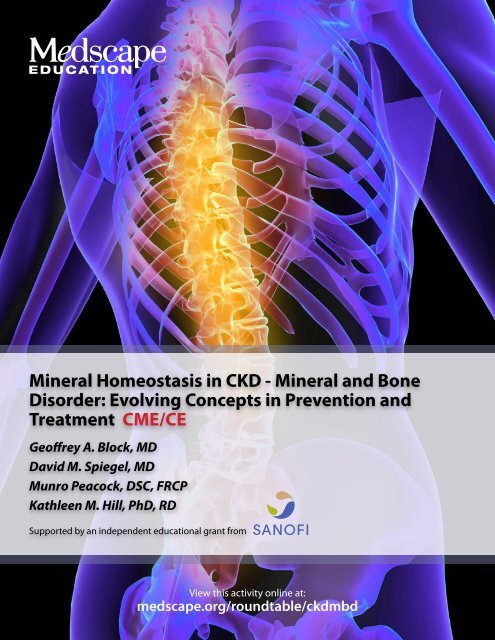




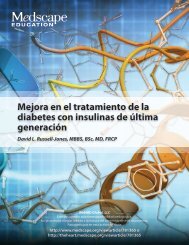
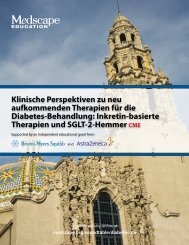
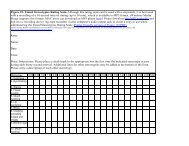

![NIH STROKE SCALE Interval: 1[ ] Baseline 2[ ] 2 hours ... - Medscape](https://img.yumpu.com/43645244/1/190x245/nih-stroke-scale-interval-1-baseline-2-2-hours-medscape.jpg?quality=85)

